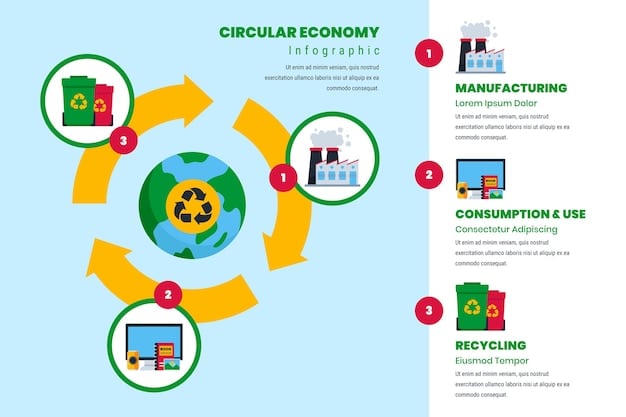Mexico’s New Environmental Regulations: Impact on US Companies

The evolving landscape of Mexico’s environmental regulations presents significant challenges and opportunities for US companies operating within its borders, necessitating adaptive strategies to ensure compliance and maintain profitability.
For US companies with operations south of the border, the regulatory environment in Mexico has always been a dynamic arena. However, recent shifts towards more stringent environmental protections are introducing a new layer of complexity. Understanding the Impact of Mexico’s New Environmental Regulations on US Companies Operating in the Country is no longer just a matter of compliance; it’s a strategic imperative that can dictate the very future of cross-border enterprises.
The Evolving Landscape of Mexican Environmental Policy
Mexico’s commitment to environmental stewardship has gained significant momentum in recent years, reflecting both global pressures and a growing awareness of domestic ecological challenges. This commitment is translating into a series of new and updated environmental regulations designed to curb pollution, promote sustainable practices, and conserve natural resources.
Driving Forces Behind Regulatory Changes
Several factors are propelling these legislative shifts. Domestically, public awareness of environmental issues like water scarcity, air pollution in urban centers, and deforestation is at an all-time high, fostering demand for stricter controls. Internationally, Mexico is party to various multilateral environmental agreements, including the Paris Agreement and the United States-Mexico-Canada Agreement (USMCA), which mandate certain environmental standards and reporting mechanisms.
- Climate Change Commitments: Mexico’s national determined contributions (NDCs) under the Paris Agreement necessitate significant reductions in greenhouse gas emissions.
- Resource Scarcity: Increasing pressure on natural resources, particularly water, is driving regulations aimed at conservation and efficient use.
- Public Health Concerns: The visible impact of pollution on community health is pushing for cleaner industrial practices and stricter emission limits.
The cumulative effect of these drivers is a regulatory framework that is becoming more robust, complex, and far-reaching. Companies, particularly those with significant industrial footprints, are finding that previous compliance strategies may no longer suffice. Proactive engagement and a deep understanding of these evolving policies are paramount.
Key Regulatory Changes and Their Scope
While the specifics vary across sectors, common themes in the new regulations include stricter emission standards for air and water, enhanced waste management protocols, increased liability for environmental damage, and greater emphasis on environmental impact assessments (EIAs). These changes are not merely incremental; they represent a fundamental shift towards holding corporations more accountable for their environmental footprint.
For instance, recent amendments to general environmental laws are clarifying enforcement mechanisms and expanding the authority of institutions like PROFEPA (Federal Attorney for Environmental Protection). This means a higher likelihood of inspections, audits, and more severe penalties for non-compliance. Companies accustomed to a more lenient regulatory environment are now facing a reality where environmental breaches can lead to significant financial penalties, operational disruptions, and reputational damage.
The evolving landscape demands not just adherence to existing rules, but also foresight. Companies must anticipate future regulatory shifts and integrate environmental considerations into their long-term business strategies, moving beyond mere compliance to genuine sustainability.
Direct Operational Impact on US Companies
The tightening of Mexico’s environmental regulations directly translates into tangible operational impacts for US companies. From increased compliance costs to potential production delays, the effects are multifaceted and demand careful planning.
Increased Compliance Costs
Perhaps the most immediate impact is the rise in compliance costs. Meeting new standards often requires significant investments in:
- New Technologies: Upgrading machinery and processes to reduce emissions, improve wastewater treatment, or enhance energy efficiency.
- Permitting and Licensing: More rigorous application processes, frequent renewals, and potentially higher fees for environmental permits.
- Monitoring and Reporting: Installation of sophisticated monitoring equipment and increased frequency/detail in environmental performance reports.
- Training and Personnel: Hiring or training staff with specialized environmental expertise to manage compliance programs.
These costs can erode profit margins, especially for companies operating on thin margins or those with older infrastructure. A thorough cost-benefit analysis of environmental investments becomes crucial, balancing regulatory mandates with economic viability.
Supply Chain Disruptions and Resource Management
The ripple effect of new regulations extends beyond a company’s direct operations into its supply chain. Suppliers in Mexico, many of whom are also adapting to these new rules, may face their own compliance hurdles, leading to:
- Increased Lead Times: Suppliers needing to retool or secure new permits might experience delays.
- Higher Input Costs: Suppliers passing on their increased compliance costs through higher prices for raw materials or components.
- Scarcity of Compliant Materials: Certain materials or services might become less available if non-compliant suppliers exit the market.
Furthermore, restrictions on water usage or waste disposal can impact resource availability and management strategies. Companies may need to invest in water recycling technologies, explore alternative raw materials, or revise their waste generation processes to align with new federal and state mandates. Proactive engagement with supply chain partners to ensure their compliance and resilience is no longer optional.

The operational adjustments necessitated by the new regulations are not trivial. They require a holistic approach that considers every facet of a company’s Mexican footprint, from factory floor to logistics and procurement. Businesses that can quickly adapt and innovate will be better positioned to not only mitigate risks but also gain a competitive advantage in a more environmentally conscious marketplace.
Legal and Enforcement Challenges for US Businesses
Beyond operational adjustments, US companies in Mexico must navigate an increasingly complex legal and enforcement environment. Understanding these challenges is key to avoiding penalties and ensuring business continuity.
Increased Scrutiny and Penalties
Mexican environmental authorities, notably PROFEPA (Federal Attorney for Environmental Protection), are demonstrating a heightened resolve in enforcing environmental laws. This translates to:
- More Frequent Inspections: Facilities are subjected to more regular and thorough compliance checks.
- Stricter Enforcement Actions: A lower tolerance for minor infractions, leading to quicker initiation of enforcement proceedings.
- Harsher Penalties: Fines are becoming steeper, and in some cases, temporary or permanent closures of facilities are being imposed for serious violations.
Legal professionals specializing in Mexican environmental law are reporting an uptick in cases involving non-compliance, indicating a more aggressive stance from regulators. The financial and reputational consequences of these actions can be substantial, underscoring the need for robust internal compliance programs and timely legal advice.
Navigating the Mexican Legal System
For US companies, understanding the nuances of the Mexican legal system is paramount. It differs significantly from the US system in procedural aspects, burden of proof, and appeal mechanisms. Companies need to be aware of:
- Local Interpretation: Environmental laws can sometimes be subject to interpretation at the state or municipal level, leading to variations in requirements.
- Bureaucratic Processes: Obtaining permits, responding to notices, or appealing decisions can be lengthy and require specific local knowledge.
- Public Participation: Increasingly, environmental impact assessments and project approvals involve public consultation processes, which can introduce delays or necessitate project modifications based on community input.
Engaging experienced Mexican legal counsel proficient in environmental regulations and administrative law is not merely a recommendation; it is a necessity for US companies seeking to maintain compliance and mitigate legal risks. Overlooking these legal intricacies can lead to costly litigation, protracted negotiations, and significant operational setbacks.
Strategic Adaptation and Competitive Advantages
While the new environmental regulations in Mexico clearly present challenges, they also offer opportunities for strategic adaptation and can, counter-intuitively, become a source of competitive advantage for agile US companies.
Embracing Sustainable Practices
Rather than viewing environmental compliance as a mere cost center, forward-thinking companies are recognizing the strategic value of sustainability. Adopting practices that go beyond minimum compliance can lead to long-term benefits:
- Operational Efficiency: Investments in energy efficiency, waste reduction, and water recycling often result in lower utility bills and reduced material costs.
- Enhanced Brand Reputation: Demonstrating a strong commitment to environmental stewardship can improve brand image, attract environmentally conscious consumers, and appeal to investors focused on ESG (Environmental, Social, and Governance) criteria.
- Innovation and R&D: The need to meet new standards can spur innovation, leading to the development of new, greener products or more efficient production processes.
For example, companies that implement robust water treatment systems not only comply with discharge limits but may also reuse treated water, reducing their reliance on municipal supplies and improving their water security in regions prone to scarcity. This proactive approach transforms a regulatory burden into an operational advantage.
Leveraging Green Technologies and Investment
The push for greener operations in Mexico is creating a market for environmental technologies and services. US companies that are leaders in sustainable manufacturing, renewable energy integration, or advanced waste management systems can find new business opportunities. Investing in or deploying these technologies within their Mexican operations can:
- Strengthen Local Partnerships: Collaborating with Mexican clean-tech providers or research institutions.
- Attract “Green” Investment: Positioning the company as an attractive target for impact investors or those seeking sustainable portfolios.
- Access Incentives: Some Mexican states or federal programs may offer incentives for adopting specific green technologies or certifications.
Essentially, the evolving regulatory environment rewards companies that are not just compliant, but genuinely sustainable. By integrating environmental considerations into their core business strategy, US companies can navigate the complexities of Mexican regulations, enhance their competitive standing, and contribute positively to both their bottom line and the planet.
Case Studies and Best Practices
Examining real-world examples offers valuable insights into how US companies are successfully navigating Mexico’s tightened environmental regulations. These case studies highlight effective strategies and demonstrate that compliance, while challenging, is achievable and can even lead to positive outcomes.
Success Stories in Compliance
One notable example is a major automotive manufacturer with significant operations in central Mexico. Faced with stricter water discharge limits and air quality standards, this company invested heavily in advanced wastewater treatment facilities and implemented a comprehensive air filtration system. They also introduced a robust environmental management system (EMS) certified to ISO 14001 standards, which includes regular internal audits and employee training programs. Their proactive approach not only ensured compliance but also led to a reduction in water consumption by 20% and significant energy savings, turning a regulatory challenge into an efficiency gain.
Another success story involves a US-based electronics assembler in Baja California. This company focused on waste reduction and recycling. By forming partnerships with local recycling facilities and redesigning their packaging to minimize material use, they achieved a nearly 90% reduction in landfill waste. This initiative not only met regulatory requirements for solid waste management but also enhanced their corporate social responsibility profile, resonating positively with both local communities and international stakeholders.
Recommended Best Practices
Based on these experiences and expert advice, several best practices emerge for US companies operating in Mexico:
- Proactive Engagement: Don’t wait for regulations to be fully enforced. Monitor proposed regulatory changes, engage with industry associations, and participate in public consultations where possible.
- Comprehensive Environmental Audits: Conduct regular, thorough environmental audits of all facilities to identify potential areas of non-compliance and assess future risks.
- Invest in Technology and Training: Allocate resources for upgrading equipment, implementing cleaner production processes, and continuously training staff on environmental best practices and regulatory updates.
- Strong Local Partnerships: Work closely with local environmental consultants, legal experts, and community leaders to gain insights and build trust.
- Develop a Robust EMS: Implement an Environmental Management System (EMS) that aligns with international standards (e.g., ISO 14001) to systematically manage environmental impacts.
These best practices underscore the importance of a holistic and forward-looking approach. Companies that treat environmental compliance as an integral part of their business strategy, rather than just a burdensome obligation, are better equipped to thrive in Mexico’s evolving regulatory landscape. They not only mitigate risks but also unlock opportunities for efficiency, innovation, and enhanced reputation.
Future Outlook and Navigating Uncertainty
The environmental regulatory landscape in Mexico is not static; it is continually evolving. US companies must therefore adopt a dynamic approach to compliance, preparing for future shifts and navigating inherent uncertainties.
Anticipating Future Regulatory Shifts
Several indicators suggest the trajectory of future environmental regulations in Mexico. Expect continued emphasis on:
- Decarbonization: As Mexico strives to meet its climate change commitments, regulations pushing for renewable energy adoption, energy efficiency, and carbon emissions reductions will likely intensify.
- Water Scarcity: Regions facing severe water stress will see even stricter regulations on water abstraction, usage, and discharge, possibly including mandatory recycling quotas for industrial users.
- Circular Economy: Moves towards a circular economy will translate into regulations promoting product stewardship, extended producer responsibility (EPR), and increased requirements for waste reduction, reuse, and recycling.
- Biodiversity Protection: Given Mexico’s rich biodiversity, expect more protective measures for ecologically sensitive areas and stricter rules regarding land use changes and species conservation.
Companies should monitor legislative calendars, engage with industry groups, and consult with environmental policy experts to anticipate these changes. Proactive scenario planning can help businesses identify potential impacts and develop adaptive strategies before new rules come into full effect.

Adapting to Political and Economic Factors
The enforcement and interpretation of environmental regulations can also be influenced by broader political and economic factors. Changes in government administrations, shifts in national priorities, or economic downturns can all affect the speed and intensity of regulatory implementation. For US companies, this means:
- Flexibility in Strategy: Business plans must be agile enough to adjust to potential changes in the regulatory enforcement climate.
- Diversification of Compliance Efforts: Relying on a single compliance strategy might be risky. A multi-pronged approach that includes technological upgrades, management system improvements, and legal safeguards offers greater resilience.
- Stakeholder Engagement: Maintaining open lines of communication with local communities, government officials, and non-governmental organizations (NGOs) can provide valuable early warnings and foster collaborative solutions.
Navigating this uncertainty requires not just legal and technical expertise, but also a deep understanding of the socio-political context in Mexico. Companies that build strong relationships and remain adaptable will be better positioned to not only comply with future regulations but also to identify new opportunities in a sustainable Mexican economy.
The Imperative of Due Diligence and Continuous Monitoring
For US companies operating or considering operations in Mexico, the dynamic environmental regulatory landscape makes robust due diligence and continuous monitoring not merely an option, but an absolute necessity. A thorough understanding of current and anticipated regulatory requirements is critical for mitigating risks and ensuring long-term viability.
Pre-Acquisition and Pre-Operation Diligence
Before any acquisition, joint venture, or establishment of new operations in Mexico, US companies must conduct comprehensive environmental due diligence. This goes beyond a cursory review and should include:
- Site Assessments: Detailed Phase I and Phase II Environmental Site Assessments (ESAs) to identify past contamination or existing environmental liabilities.
- Permit Review: A thorough examination of all existing environmental permits, licenses, and authorizations to ensure they are current, complete, and adequately cover planned activities.
- Compliance History: Review of the target company’s or site’s environmental compliance record, including any past violations, fines, or enforcement actions.
- Waste Management Audit: An audit of waste generation, storage, treatment, and disposal practices to ensure adherence to current hazardous and non-hazardous waste regulations.
Failing to conduct adequate diligence can result in inheriting significant environmental liabilities, unexpected cleanup costs, and regulatory penalties that severely undermine the investment. This upfront investment in diligence saves substantial costs and headaches down the line.
Continuous Environmental Performance Monitoring
Once operations are established, continuous monitoring of environmental performance and regulatory
updates is essential. The Mexican regulatory environment is not static, and new laws, standards, or enforcement priorities can emerge with little warning. Key aspects of continuous monitoring include:
- Regular Internal Audits: Implementing a schedule for internal environmental compliance audits to proactively identify deviations from permits, regulations, or company policies.
- Legislative Tracking: Subscribing to regulatory alert services or engaging local legal counsel to stay abreast of proposed and enacted environmental legislation at federal, state, and municipal levels.
- Performance Metrics: Establishing clear environmental performance indicators (EPIs) for key areas such as emissions, water usage, waste generation, and energy consumption, and regularly reporting against these metrics.
- Stakeholder Engagement: Maintaining an ongoing dialogue with local environmental authorities, community leaders, and industry associations to understand local concerns and anticipate enforcement trends.
This proactive approach allows companies to adjust their operations and compliance strategies in real-time, preventing minor issues from escalating into major regulatory challenges. Ultimately, diligent monitoring fosters a culture of environmental responsibility that benefits both the business and the environment, ensuring that US companies can operate effectively and ethically within Mexico’s evolving regulatory framework.
| Key Point | Brief Description |
|---|---|
| 📊 Regulatory Evolution | Mexico’s environmental laws are becoming stricter, driven by global agreements and domestic needs. |
| 💰 Increased Costs | Companies face higher expenses for compliance, new tech, and ongoing monitoring. |
| ⚖️ Legal Scrutiny | Stricter enforcement and penalties from Mexican environmental authorities are common. |
| 💡 Strategic Advantage | Proactive sustainability can lead to efficiency gains and improved brand reputation. |
Frequently Asked Questions About Mexico’s Environmental Regulations
▼
Mexico’s commitment to stricter environmental regulations is influenced by several factors, including international agreements like the Paris Agreement and USMCA, increasing domestic environmental awareness, and pressing concerns over issues such as climate change, water scarcity, and public health impact from pollution. This reflects a global trend towards greater environmental accountability.
▼
The primary financial impacts include increased compliance costs for new technologies, permitting, monitoring, and training. Non-compliance can lead to significant fines and operational disruptions. Companies may also face higher costs from suppliers who pass on their own compliance expenses, affecting overall profitability.
▼
To ensure compliance, US companies should conduct thorough environmental audits, invest in upgraded technology and ongoing staff training, and implement robust environmental management systems (EMS). Engaging experienced local legal and environmental consultants is crucial for navigating Mexican legal intricacies and staying updated on regulatory changes.
▼
Absolutely. By embracing sustainable practices beyond mere compliance, US companies can achieve operational efficiencies, enhance their brand reputation, and attract green investments. Leading in green technologies or sustainable manufacturing can also create new market opportunities and strategic advantages within Mexico’s evolving economy.
▼
Companies should anticipate continued regulatory focus on decarbonization, water scarcity, circular economy principles, and biodiversity protection. Monitoring legislative developments, engaging with industry associations, and maintaining strong local relationships are key to preparing for and adapting to these ongoing shifts in environmental governance.
Conclusion
The evolving environmental regulatory landscape in Mexico presents a formidable, yet manageable, set of challenges for US companies. From navigating increased compliance costs and stricter judicial enforcement to mitigating supply chain disruptions, the imperative for strategic adaptation is clear. However, viewing these shifts not merely as burdens but as catalysts for innovation and improved sustainability can unlock significant competitive advantages. By investing in robust due diligence, adopting advanced environmental technologies, and fostering strong local partnerships, US companies can not only ensure compliance but also enhance their operational efficiency and secure their long-term viability in the dynamic Mexican market. The embrace of sustainable practices is no longer an option but a core component of successful cross-border business.





